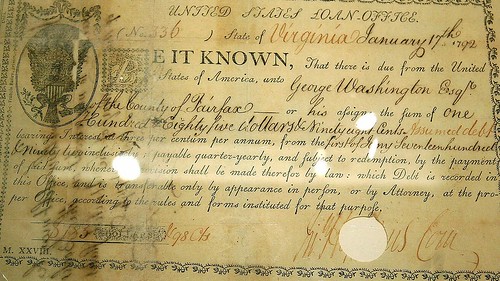
PREV ARTICLE
NEXT ARTICLE
FULL ISSUE
PREV FULL ISSUE
BBC ON THE ORIGINS OF THE DOLLAR SIGNIt's no scholarly footnoted article (so I have no idea where they got their facts from, and there's no mention of Eric P. Newman's great work), but this BBC article, one of its most read in 2019, discussed the history and development of the U.S. dollar sign. Thanks to Dick Hanscom for sending this along. Here's an excerpt. -Editor  This vintage bond signed by former US president George Washington in 1792 contains the first use of the dollar sign on an American financial document The dollar sign is among the world's most potent symbols, emblematic of far more than US currency. It's shorthand for the American dream and all the consumerism and commodification that comes with it, signifying at once sunny aspiration, splashy greed and rampant capitalism. It's been co-opted by pop culture (think Ke$ha when she first started out, or any number of fast-fashion t-shirts) and borrowed by artists (Salvador Dali fashioned a moustache from it, Andy Warhol rendered it in acrylic and silkscreen, creating an iconic body of work that itself now sells for $$$). It's used widely in computer coding and it provides money-mouth emoji with its dazed eyes and lolling tongue. Yet despite its polyglot ubiquity, the origins of the dollar sign remain far from clear, with competing theories touching on Bohemian coins, the Pillars of Hercules and harried merchants. The British pound sign has a history going back 1,200 years, when it was first used by the Romans as an abbreviation for ‘libra pondo', the empire's basic unit of weight. As any amateur astrologer will tell you, libra means scales in Latin, and libra pondo literally translates as ‘a pound by weight'. In Anglo-Saxon England, the pound became a unit of currency, equivalent to – surprise, surprise – a pound of silver. Vast riches, in other words. But along with the Roman name, the Anglo-Saxons borrowed the sign, an ornate letter ‘L'. The crossbar came along later, indicating that it's an abbreviation, and a cheque in London's Bank of England Museum shows that the pound sign had assumed its current form by 1661, even if it took a little longer for it to become universally adopted. 
Warhol dollar sign artwork See the full article for a set of competing theories on the dollar sign's origin, but also have a look at some of our earlier discussions on the topic, linked below. Also,
see this page from the site of Gly Davies, author of the 2002 book, A History of Money:
Question: where is the illustrated 1792 George Washington bond? Is it part of a museum or private collection? And where exactly is the dollar sign the caption refers to? The bond is hard to read because writing on the back is bleeding through. -Editor To read the complete article, see:
To read earlier E-Sylum articles, see:
Wayne Homren, Editor The Numismatic Bibliomania Society is a non-profit organization promoting numismatic literature. See our web site at coinbooks.org. To submit items for publication in The E-Sylum, write to the Editor at this address: whomren@gmail.com To subscribe go to: https://my.binhost.com/lists/listinfo/esylum All Rights Reserved. NBS Home Page Contact the NBS webmaster 
|